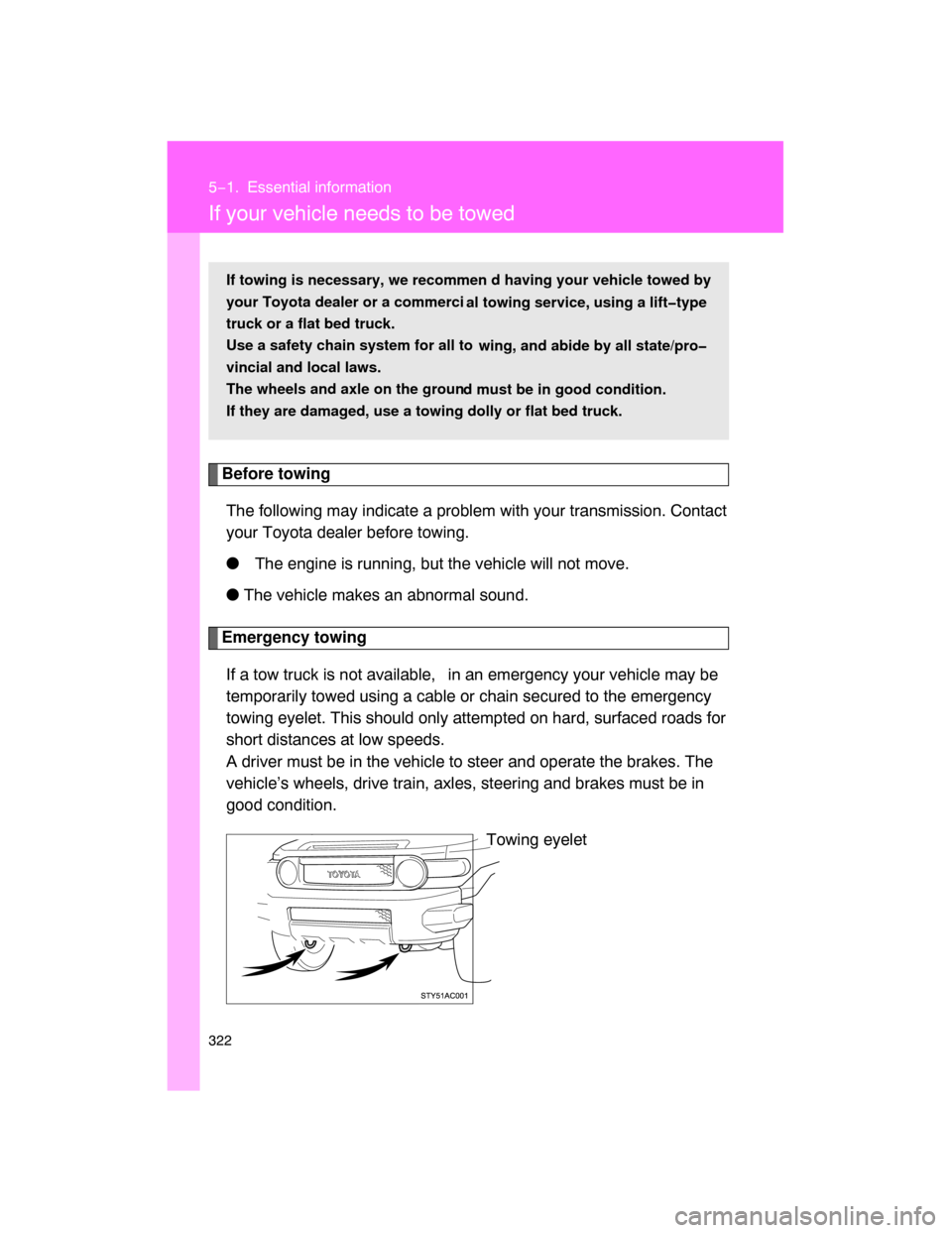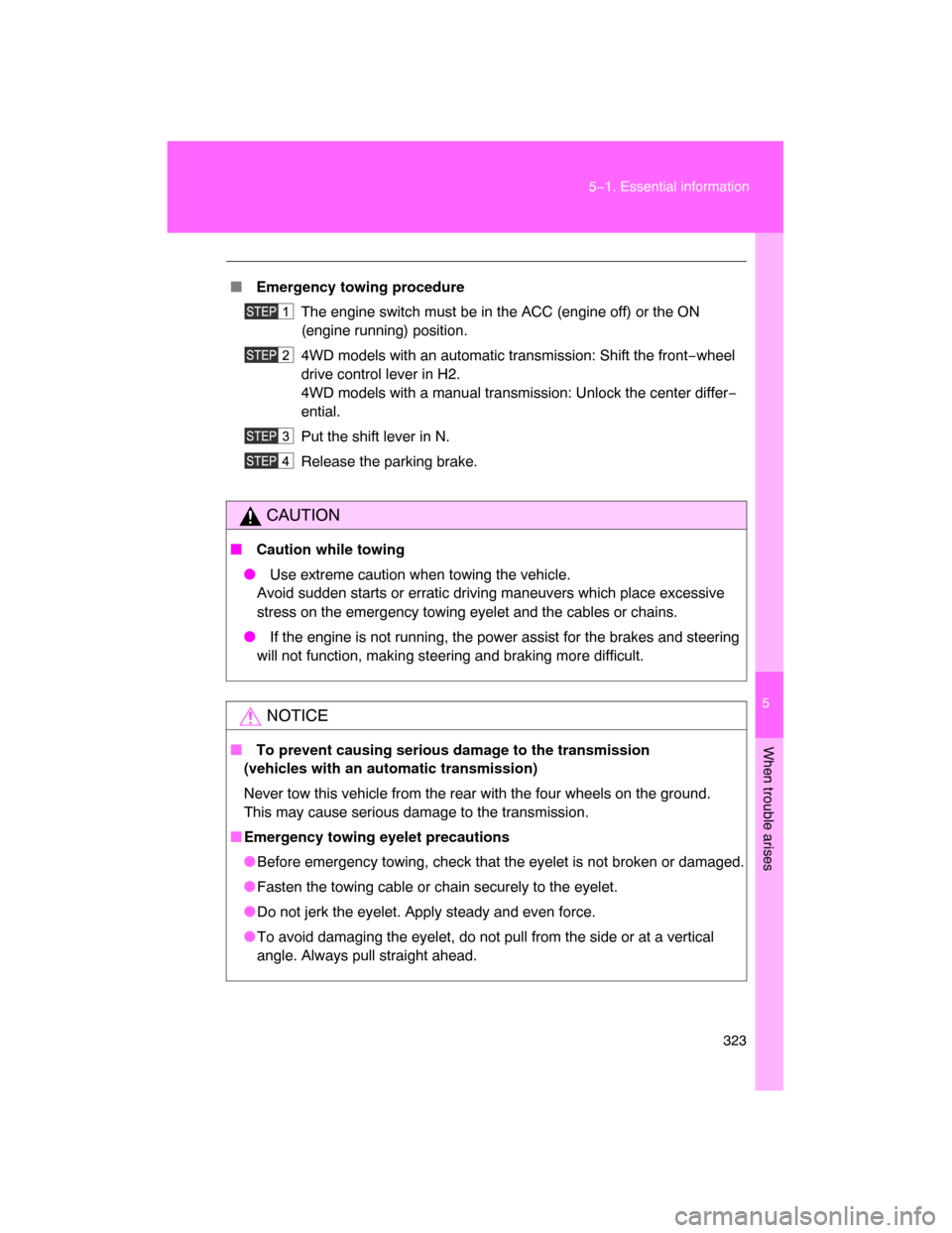Page 285 of 400

289
4−3. Do−it−yourself maintenance
4
Maintenance and care
�Routine tire inflation pressure checks
The tire pressure warning system doe s not replace routine tire inflation
pressure checks. Make su re to check tire inflation pressure as part of
your routine of daily vehicle checks.
�Maximum load of tire
Check that the maximum load of the re placed tire is greater than 1/2 of
the Gross Axle Weight Ratings (GAWR) of either the front axle or the
rear axle, whichever is greater.
As for the maximum load of the tire, see the load limit at maximum cold
tire inflation pressure mentioned on the sidewall of the tire, and as for the
Gross Axle Weight Ratings (GAWR)
, see the Certification Label.
( P. 292, 363, 375).
�Tire types
1 Summer tires
Summer tires are high−speed performance tires best suited to highway
driving under dry conditions. Since summer tires do not have the same
traction performance as snow tire
s, summer tires are inadequate for
driving on snow−covered or icy roads. For driving on snow−covered
roads or icy roads, the use of
snow tires is recommended. When
installing snow tires, be sure to replace all four tires.
2 All season tires
All season tires are designed to prov ide better traction in snow and to
be adequate for driving in most winter conditions, as well as for use
year round. All season tires, however, do not have adequate traction
performance compared with snow tires in heavy or loose snow. Also,
all season tires fall short in acceleration and handling performance
compared with summer tires in highway driving.
3Snow tires
For driving on snow−covered roads or icy roads, we recommend using
snow tires. If you need snow tires,
select tires of the same size, con−
struction and load capacity as the or iginally installed tires. Since your
vehicle has radial tires as original equipment, make sure your snow
tires also have radial construction. Do not install studded tires without
first checking local regulations for possible restriction. Snow tires
should be installed on all wheels. (
P. 169)
Page 287 of 400

291
4−3. Do−it−yourself maintenance
4
Maintenance and care
CAUTION
�Tire pressure warning system operation
The tire pressure warning system may not provide warning immediately
if a tire bursts or if
sudden air leakage occurs.
�When inspecting or replacing tires
Observe the following precautions to prevent accidents. Failure to do so
may cause damage to parts of the drive train, as well as dangerous han−
dling characteristics, which may le
ad to fatal or injury accidents.
�Do not mix tires of different makes, models, tread patterns or tread−
wear.
�Do not use tire sizes other than those recommended by Toyota.
�Do not mix radial, bias−belted, or bias−ply tires.
�Do not mix summer, all season and winter tires.
�Do not use tires that have been used on another vehicle.
�Do not use tires if you do not know how they were used previously.
NOTICE
�Repairing or replacing tires, wheels and tire pressure warning
valves and transmitters
When removing or fitting the wheels, tires or the tire pressure warning
valve and transmitter, contact your Toyota dealer as the tire pressure
warning valve and transmitter may be damaged if not handled correctly.
�Do not use puncture sealant sprays to repair flats
Puncture sealant sprays may damage tire pressure warning valves and
transmitters.
�Driving on rough roads
Take particular care when driving on roads with loose surfaces or pot−
holes.
These conditions may cause losses in tire inflation pressure, reducing
the cushioning ability of the tires. In
addition driving on rough roads may
cause damage to the tires themselves, as well as the vehicle’s wheels
and body.
�If tire inflation pressures become low while driving
Do not continue driving, or your tires and/or wheels may be ruined.
Page 290 of 400

294 4−3. Do−it−yourself maintenance
�Instructions for checking tire inflation pressure
When checking tire inflation pressure, observe the following:
�Check only when the tires are cold.
If your vehicle has been parked for at least 3 hours and has not been
driven for more than 1 mile or
1.5 km, you will get an accurate cold
tire inflation pressure reading.
�Always use a tire pressure gauge.
The appearance of the tire can be mi
sleading. In addition, tire infla−
tion pressures that are even just a few pounds off can degrade ride
and handling.
�Do not bleed or reduce tire inflation pressure after driving. It is normal
for the tire inflation pressure to be higher after driving.
�Never exceed the vehicle capacity weight.
Passengers and luggage weight should be placed so that the vehicle
is balanced.
CAUTION
�Proper inflation is critical to save tire performance
Keep your tires properly inflated.
Otherwise, the following conditions
may occur and result in an accident
causing death or serious injury.
�Excessive wear
�Uneven wear
�Poor handling
�Possibility of blowouts resulting from overheated tires
�Poor sealing of the tire bead
�Wheel deformation and/or tire separation
�A greater possibility of tire damage from road hazards
Page 292 of 400

296
4−3. Do−it−yourself maintenance
Wheels
�When replacing wheels
The wheels of your Toyota are equipped with sensors that allow the tire
pressure warning system sensors to provide advanced warning in the
event of a loss in tire inflation pressure. Whenever wheels are replaced,
the tire pressure warning valve and transmitter must be switched over
from the old wheels. (
P. 288) If a wheel is bent, cracked or heavily corroded, it should be
replaced.
Otherwise, the tire may separate from the wheel or cause loss of
handling control.
� Wheel selection
When replacing wheels, care should be taken to ensure that
they are equivalent to those removed in load capacity, diameter,
rim width, and offset.
Replacement wheels are available at your Toyota dealer.
Toyota does not recommend using:
�
Wheels of different sizes or types
�Used wheels
�
Bent wheels that have been straightened
�
Aluminum wheel precautions (if equipped)
�Use only Toyota wheel nuts and wrench designed for use with
your aluminum wheels.
� When rotating, repairing or changing your tires, check that the
wheel nuts are still tight after driving 1000 miles (1600 km).
�
Be careful not to damage the aluminum wheels when using
tire chains.
� Use only Toyota genuine balance weights or equivalent and a
plastic or rubber hammer when balancing your wheels.
Page 293 of 400
297
4−3. Do−it−yourself maintenance
4
Maintenance and care
CAUTION
�When replacing wheels
�Do not use wheels that are a different size from those recommended in
the Owner ’s Manual, as this may result in loss of handling control.
�Never use an inner tube in a leaking wheel which is designed for a
tubeless tire. Doing so may result in an accident, causing death or seri−
ous injury.
NOTICE
�Replacing tire pressure warning valves and transmitters
�Because tire repair or replacement may affect the tire pressure warn−
ing valves and transmitters, make su re to have tires serviced by your
Toyota dealer or other qualified service shop. In addition, make sure to
purchase your tire pressure warning valves and transmitters at your
Toyota dealer.
�Ensure that only Genuine Toyota wheels are used on your vehicle.
Tire pressure warning valves and transmitters may not work properly
with non−genuine wheels.
Page 307 of 400
311
4−3. Do−it−yourself maintenance
4
Maintenance and care
� Under the instrument panel
FuseAmpere Circuit
1 IGN 10 AMultiport fuel injection system/
sequential multiport fuel injection
system, anti−lock brake system,
vehicle stability control system,
traction control system, active trac−
tion control system, AUTO LSD
system, SRS airbag system, front
passenger occupant classification
system
2 GAUGE 7.5 A Meter and gauge
3 FR WIP−WSH 30 A Windshield wipers and washer
4 4WD/DIFF 20 AFour−wheel drive system, rear dif−
ferential lock system
5 PWR OUTLET 15 A Power outlet
6 RR WSH 15 A
Rear window wiper and washer,
multiplex communication system
1
5678
91011
1223 4
Page 317 of 400

322
5−1. Essential information
If your vehicle needs to be towed
Before towing
The following may indicate a problem with your transmission. Contact
your Toyota dealer before towing.
� The engine is running, but the vehicle will not move.
�
The vehicle makes an abnormal sound.
Emergency towing
If a tow truck is not available, in an emergency your vehicle may be
temporarily towed using a cable or chain secured to the emergency
towing eyelet. This should only attempted on hard, surfaced roads for
short distances at low speeds.
A driver must be in the vehicle to steer and operate the brakes. The
vehicle’s wheels, drive train, axles, steering and brakes must be in
good condition.
Towing eyelet
If towing is necessary, we recommen d having your vehicle towed by
your Toyota dealer or a commerci
al towing service, using a lift�type
truck or a flat bed truck.
Use a safety chain system for all to
wing, and abide by all state/pro�
vincial and local laws.
The wheels and axle on the groun
d must be in good condition.
If they are damaged, use a towing dolly or flat bed truck.
Page 318 of 400

5
When trouble arises
323 5−1. Essential information
� Emergency towing procedure
The engine switch must be in the ACC (engine off) or the ON
(engine running) position.
4WD models with an automatic transmission: Shift the front−wheel
drive control lever in H2.
4WD models with a manual transmission: Unlock the center differ−
ential.
Put the shift lever in N.
Release the parking brake.
CAUTION
� Caution while towing
� Use extreme caution when towing the vehicle.
Avoid sudden starts or erratic driving maneuvers which place excessive
stress on the emergency towing eyelet and the cables or chains.
� If the engine is not running, the power assist for the brakes and steering
will not function, making steering and braking more difficult.
NOTICE
� To prevent causing serious damage to the transmission
(vehicles with an automatic transmission)
Never tow this vehicle from the rear with the four wheels on the ground.
This may cause serious damage to the transmission.
�Emergency towing eyelet precautions
�Before emergency towing, check that the eyelet is not broken or damaged.
�Fasten the towing cable or chain securely to the eyelet.
�Do not jerk the eyelet. Apply steady and even force.
�
To avoid damaging the eyelet, do not pull from the side or at a vertical
angle. Always pull straight ahead.